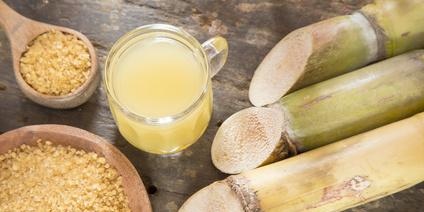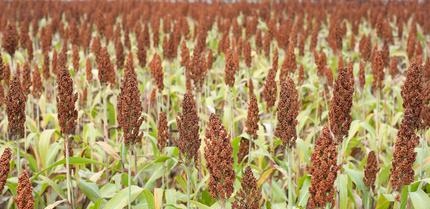|
 How to imagine sorghum? As easy as pie. Take the usual brooms that come from the south. This is broom sorghum. Turn the broom upside down - that's how it grows, only it can be much higher. How to imagine sorghum? As easy as pie. Take the usual brooms that come from the south. This is broom sorghum. Turn the broom upside down - that's how it grows, only it can be much higher.
And for a broom, only the broom itself is cut. On it, here and there, red grains, similar to millet (a relative of millet), are still preserved, if the broom is new.
Sorghum grains, like millet, are a favorite food of chickens and birds in general. However, it is not only poultry that loves sorghum and millet. Sparrows, for example, often attack with armada on sorghum and millet fields. In particular, they annoy the experimental stations, where they sow different varieties on small plots. Scientists have tested different methods of anti-sparrow protection. We came to a consensus: the best tool is a firecracker. This is a piece of iron pipe with a simple device. Charge it with carbide. A blank shot is fired. The sparrows fly away. It seems that this is the first case of practical application of the saying: "From a cannon to sparrows."
 It is now up to the industrial production of anti-sparrow guns. It is now up to the industrial production of anti-sparrow guns.
Once upon a time, people tried to make sugar from sorghum. In Russia, in the middle of the nineteenth century, in one of the magazines, someone published an article where he described in detail how he squeezed juice, evaporated it in a tablespoon and got the usual snow-white crystals. There were immediately followers. One of them immediately planted two tithes (more than two hectares!). I squeezed out the juice, but did not receive any crystals. In addition, he also made trouble. In those years, the proverb was in vogue: "Sorghum feeds both people and the land." Believing in the proverb, the poor fellow thought that at least the soil would improve.
Instead, the opposite happened. Sorghum dug so hard into the virgin steppe that it was not easy to pull out the roots. A common plow in those years broke. I had to take up a shovel, digging in from four sides. Only then did the plant give up. But try to extract from the earth all 42 thousand roots that remained on two tithes! And that would be half the trouble. The torn roots then lay for a long time, littering the arable land, because they did not rot at all under the steppe sun.
So, sorghum is not very good for sugar production yet. Sugar cane remains. It really looks a little like our common reed that grows in wet places, along the shores of lakes and the outskirts of swamps. Long, narrow, like all cereals, the leaves are a meter or a half long. The same articulated knotty barrel. The same underground rhizome. The panicle is at the top. And up to six meters high, like our reeds.
Difference in stem thickness. He is like a stick in sugar. And stronger. In Cuba, the reed accompanies man everywhere. He wanted something sweet, left the road, cut off a piece of the stem with a penknife and suck it like candy. The sugar is melting. What remains is inedible wood, like sawdust. They spit it out. Machateros - reed cutters - do it even easier. When you feel thirsty, they take a reed pole, break it in half with a sharp blow, raise it over your head and substitute your mouth. The juice pours out like from a bottle. It is said to quench thirst in the heat. And most importantly, it is hygienic. There is, however, an inconvenience. You must immediately rinse your mouth with water, otherwise your teeth quickly deteriorate, like those who suck a lot of candies.
In Bombay they do it differently. On the streets are huge meat grinder, the size of a desk. Nearby lies a pile of poles, like brushwood gathered in the forest. At the first request, the seller puts a pole into the mouth of the grinder. There is a crunching sound, you substitute the glass, and the juice is filtered into it. Of course, you also need to rinse your teeth.
Reed is a perennial plant. Once you plant a cutting, then harvest for three or four years. Trunks are cut down, and new ones appear in their place from the rhizome.Sometimes the plantation works for 10 years. The only inconvenience during harvesting is the leaves. They get in the way. Sometimes they are simply burnt on the vine. What such an event leads to, I was convinced on the islands of Fiji. In the morning I went out of the hotel and was dumbfounded. Ahead, on a green plain covered with reed plantations, a fiery tornado was raging. The smoke whirled up like a dark rope towards the sky and there spread into an ominous cloud.
- They are burning reeds, - explained the guide. - Trunks do not burn. Then they are easier to recycle.
The mountains were blue in the distance. I expected to see lush rainforests on them. And take a picture for memory. After breakfast we went on a hike past those mountains. We drove a hundred miles. The mountains turned out to be not green, but black. Everything burned down on them. All rainforests. The fire from the plantation went into the forest.
Of course, the reed itself often suffers from various adversities. The first is hurricanes. Most of all, it seems, goes to the island of Mauritius. History has preserved the memory of the hurricane of 1892. On April 29, the wind reached a terrifying speed of 103 miles per hour. A whirlwind swept through the very center of the island. The reeds crackled and bent almost to the ground. Then the hurricane turned sharply and blew in the opposite direction at the same crazy speed. The reed could not stand this. Half of the harvest was gone. Historians estimate that Mauritius was defeated 42 times in half a century. Almost every year there is a hurricane.
 If only it was limited to hurricanes. To them, in addition, earthquakes. 1934 year. Catastrophic earthquake in Bihar. The reed was not particularly damaged, but the factories fell apart. I had to transport raw materials to other places. Even worse are pests. The list of their invasions has made a long list. Either the invasion of mice in Egypt, the caterpillars in Sicily, the excesses of ants in Cuba and Puerto Rico. If only it was limited to hurricanes. To them, in addition, earthquakes. 1934 year. Catastrophic earthquake in Bihar. The reed was not particularly damaged, but the factories fell apart. I had to transport raw materials to other places. Even worse are pests. The list of their invasions has made a long list. Either the invasion of mice in Egypt, the caterpillars in Sicily, the excesses of ants in Cuba and Puerto Rico.
But perhaps the most terrible story happened to the reed at the beginning of this century in the Hawaiian Islands. Suddenly sugarcane began to die from root rot. The culprit of the disaster turned out to be the Veselka reddish mushroom. It resembles ordinary edible mushrooms in that it has a stem and a cap. And although the design of this mushroom is different, outwardly everything is very similar. Only the hat is covered in smelly mucus to attract flies. The chief sanitary doctor of the plantation was horrified when he saw how many Veselok had settled under the reed bushes. In addition, a myriad of flies appeared, attracted by the sickening "scent" of mushrooms. News of the mushroom invasion came from all the islands.
The planters realized that the fate of the reed was sealed. They began to prepare to replace it with another culture. However, the mushrooms disappeared as suddenly as they appeared. Why they multiplied so suddenly and what made them disappear is still a mystery. Since then, we have not heard about Veselka any more. But the anxiety still lingered.
What if the mushroom appears again? What if some other parasite emerges from oblivion and destroys the reeds?
The eternal anxiety over the reed is nerve-racking. In the 80s of the last century, planters were seized by the fear that the reeds were degenerating. There are good reasons for concern: they have been propagated by cuttings for hundreds of years. Seeds - never. It cannot be said, of course, that the reed does not bloom. In Colombia, its panicles are visible at any time of the year. But the seeds do not sprout - and that's it! How many attempts have been made - all in vain. Finally, at the end of the century, the first shoots were obtained in Java. Seed generation is safer, more resistant and stronger against pests.
The history of sugar is as old as the world. And the reed too. But in the most recent years, the fate of the reed has changed dramatically. Humanity has remembered that sugar can be turned into alcohol, and alcohol is an excellent fuel, which, by the way, almost does not pollute the environment. At the end of World War II, alcohol-fueled cars were already operating in Cuba. Therefore, Brazil is now trying to convert vehicles to alcohol. It is only slightly more expensive than gasoline. Fuel is a bit tough in Brazil, and the cane grows so fast ... True, economists are worried: will there be enough sugar for food if Brazilians waste it in car engines?
A. Smirnov. Tops and roots
|